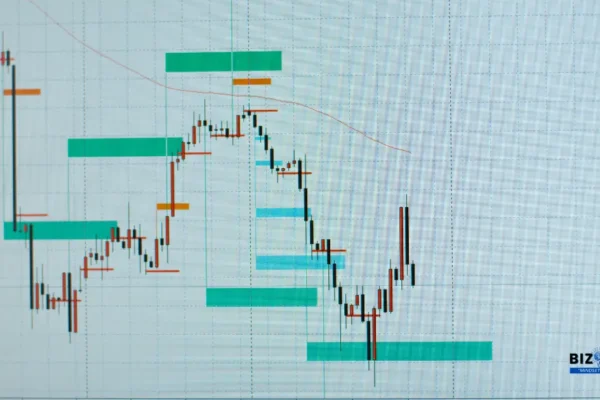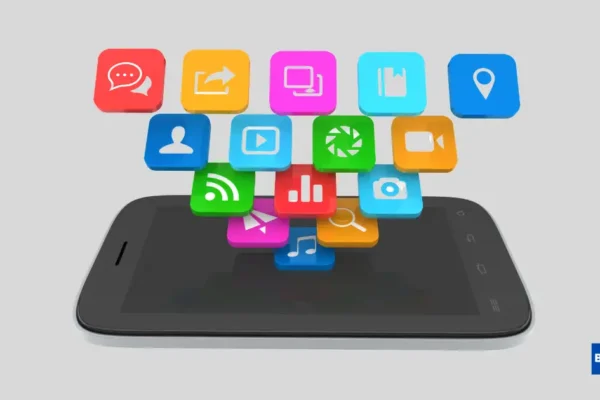

In the heart of Silicon Valley, countless entrepreneurs dream of building the next game-changing startup. Yet, the harsh reality remains stark: 90% of startups fail. Behind each failure lies a story of passion, dedication, and often, a fundamental misunderstanding of what customers actually want. This is where the Minimum Viable Product (MVP) emerges as more than just a development methodology—it becomes the lighthouse guiding startups through the treacherous waters of uncertainty toward sustainable success.
The statistics paint a sobering picture of entrepreneurial reality. Research reveals that 42% of startups fail because they build products nobody wants. Another 29% run out of funding, while 23% struggle with team issues. These numbers aren’t just data points; they represent dreams deferred, savings depleted, and the emotional toll of entrepreneurial failure. However, within these statistics lies hope: startups that embrace MVP development are 35% more likely to secure funding and 50% more likely to achieve product-market fit.
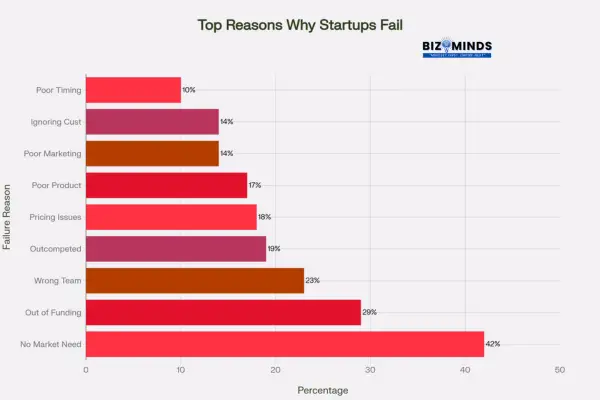
Top reasons why startups fail, showing how Minimum Viable Product (MVP) development can address the leading causes of failure
The Foundation: Understanding Minimum Viable Product (MVP) in the Modern Startup Ecosystem
Defining the MVP Revolution
The concept of Minimum Viable Product, popularized by Eric Ries in his groundbreaking book “The Lean Startup,” represents a fundamental shift in how we approach product development. An MVP is not simply a stripped-down version of your final vision—it’s a strategic tool designed to test hypotheses, validate assumptions, and learn from real customer behavior with minimal resource investment.
The concept of a Minimum Viable Product (MVP), as explained by Eric Ries, revolves around launching a product with just enough features to validate market demand and gain actionable customer feedback while keeping development costs low. This definition captures the essence of what makes MVPs so powerful: they’re learning instruments disguised as products.
The Emotional Journey of Minimum Viable Product Development
Building a Minimum Viable Product (MVP) is fundamentally an emotional journey. It requires entrepreneurs to confront their deepest fears: What if customers don’t want what I’m building? What if my grand vision isn’t viable? This vulnerability, while uncomfortable, is precisely what makes MVPs so valuable. They convert fear into measurable data, turn assumptions into valuable insights, and change uncertainty into practical, actionable intelligence.
The psychological benefits of Minimum Viable Product development include:
- Reduced anxiety through early validation
- Increased confidence from real customer feedback
- Enhanced focus on solving genuine problems
- Greater resilience through iterative learning
- Stronger emotional connection to customer needs
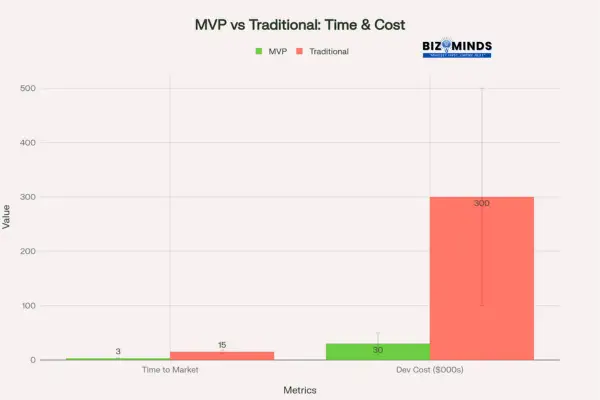
Comparison of Minimum Viable Product (MVP) development versus traditional development approaches showing significant advantages in both time to market and development costs
The Stark Reality: Why Traditional Development Fails
Time and Cost Implications
The traditional approach to product development often resembles shooting in the dark with expensive ammunition. Companies invest 12-18 months and $100,000 to $500,000 developing products based on assumptions rather than validated learning. In contrast, Minimum Viable Product development requires just 2-4 months and $10,000 to $50,000, offering a pathway to validation that’s both faster and more financially responsible.
These numbers tell a human story. Traditional development means entrepreneurs bet their life savings, their family’s financial security, and months or years of their lives on invalidated assumptions. The emotional weight of this approach is crushing. When these products fail—as 90% of startups do—the personal cost extends far beyond financial loss.
The Innovation Accounting Revolution
Traditional accounting measures outputs: features built, lines of code written, meetings held. Minimum Viable Product (MVP) development introduces “innovation accounting”—measuring progress through validated learning. This shift represents a fundamental change in how we define and measure startup success.
Key metrics in innovation accounting include:
- Customer acquisition rates during Minimum Viable Product phase
- User engagement with core features
- Revenue validation through early monetization tests
- Product-market fit indicators through retention rates
- Learning velocity through iteration cycles
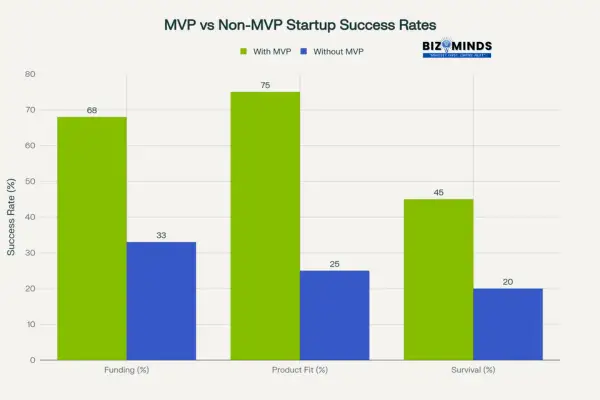
Success rates comparison between startups using Minimum Viable Product (MVP) development approach versus traditional development methods
Success Stories: Minimum Viable Product (MVPs) That Changed the World
Airbnb: From Air Mattresses to Global Empire
The Airbnb story begins with two roommates in San Francisco who couldn’t afford their rent. Brian Chesky and Joe Gebbia’s solution was beautifully simple: rent out air mattresses in their apartment during a design conference. They created a basic website with photos of their space and attracted three paying guests.
This humble beginning generated around $200 per week in revenue, but more importantly, it validated a fundamental hypothesis: people would stay in strangers’ homes if the experience was trustworthy and affordable. Today, Airbnb serves 150 million users and represents a triumph of Minimum Viable Product methodology.
The emotional resonance of Airbnb’s story lies in its relatability. Two friends struggling to pay rent transformed their financial desperation into a billion-dollar business by solving a problem they personally experienced. Their Minimum Viable Product (MVP) wasn’t sophisticated—it was authentic, addressing a real need with genuine care.
Dropbox: The Power of a Three-Minute Video
Drew Houston faced a technical challenge that seemed insurmountable: building a file synchronization system that worked seamlessly across devices required complex infrastructure that was expensive and time-consuming to develop. Instead of building the product first, Houston created a three-minute demonstration video showing how Dropbox would work.
This video, filled with tech humor and insider references, generated 75,000 sign-ups in one day. The production cost? Approximately $50,000—a fraction of what building the actual product would have required. More importantly, it validated massive market demand before a single line of code was written.
The emotional intelligence behind this approach is profound. Houston understood that his target audience—tech-savvy early adopters—would appreciate both the product concept and the clever validation method. The video didn’t just demonstrate functionality; it built community and excitement.
Instagram: The Art of Ruthless Focus
Instagram’s origin story embodies the power of strategic simplification. The app began as Burbn, a complex social platform combining photo sharing, location check-ins, and social gaming features. However, user behavior data revealed a startling truth: people overwhelmingly used just one feature—photo sharing.
Founders Kevin Systrom and Mike Krieger made a courageous decision: they stripped away everything except the photo-sharing functionality, creating Instagram. This intense focus turned a previously cluttered app into a worldwide sensation, leading to its acquisition by Facebook for $1 billion in 2012.
The emotional lesson here is about letting go. Entrepreneurs often fall in love with their comprehensive visions, but Instagram’s success required the emotional maturity to kill features they had worked hard to build. This willingness to simplify based on user feedback exemplifies Minimum Viable Product thinking at its finest.
Uber: Starting with Premium Simplicity
Uber’s Minimum Viable Product story begins with a simple frustration: the difficulty of hailing a cab in San Francisco. Travis Kalanick and Garrett Camp’s solution was elegantly focused—an app that connected users with black car services. The initial version, called UberCab, served only San Francisco and offered premium vehicles exclusively.
This geographic and service limitation was strategic brilliance. By focusing on one city and one type of service, Uber could perfect their logistics, pricing model, and user experience before expanding. The premium positioning also ensured early adopters were financially capable and forgiving of initial imperfections.
The expansion strategy was methodical: city by city, vehicle type by vehicle type, always learning and iterating. Today, Uber operates in hundreds of cities globally with 93 million active users, but it all began with a simple solution to a personal problem.
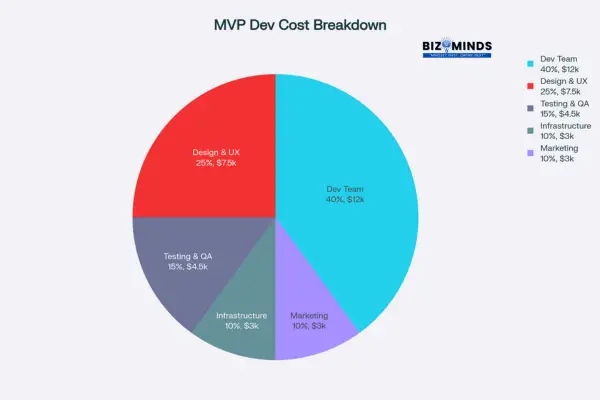
Breakdown of typical Minimum Viable Product (MVP) development costs showing how budget is allocated across different components
The Economics of Minimum Viable Product Development
Cost Breakdown and Financial Intelligence
Understanding Minimum Viable Product economics requires examining both direct costs and opportunity costs. The typical Minimum Viable Product development budget breaks down strategically across essential components, with the development team consuming 40% of resources, design and UX taking 25%, testing and QA requiring 15%, while infrastructure and marketing each demand 10%.
These allocations reflect strategic priorities. The heavy investment in development and design ensures the core product experience validates key hypotheses, while the balanced approach to testing and infrastructure prevents technical debt from undermining future growth.
Return on Investment: The Minimum Viable Product Advantage
MVPs generate superior returns through multiple mechanisms. Companies using MVPs achieve ROI rates of 150% or higher during validation phases, compared to traditional development approaches that often show negative returns until much later in the product lifecycle.
Key ROI drivers include:
- Reduced development risk through early validation
- Faster time-to-revenue through immediate customer engagement
- Lower customer acquisition costs through word-of-mouth generated by authentic products
- Enhanced investor appeal through demonstrated traction
- Accelerated learning cycles leading to better product-market fit
The Hidden Costs of Not Building a Minimum Viable Product (MVP)
The true cost of avoiding Minimum Viable Product (MVP) development extends beyond immediate financial implications. Startups that bypass MVP development face 80% failure rates compared to 45% failure rates for MVP-adopting startups. This difference represents not just business success, but personal fulfillment, family financial security, and the emotional well-being of entrepreneurial teams.
The Science behind Minimum Viable Product (MVP) Success
Validated Learning: The Core Methodology
Validated learning transforms startup development from art to science. This methodology requires entrepreneurs to formulate hypotheses, design experiments, and measure results with the same rigor applied in academic research. The emotional benefit is profound: decisions become data-driven rather than fear-driven.
The validated learning process includes:
- Hypothesis formation based on customer problems
- Experiment design to test specific assumptions
- Metric selection for meaningful measurement
- Data collection through real customer interactions
- Analysis and iteration based on learning outcomes
Build-Measure-Learn: The Feedback Loop Revolution
The Build-Measure-Learn feedback loop represents the operational heart of Minimum Viable Product (MVP) methodology. This cycle transforms the traditional linear development process into a dynamic system of continuous improvement. Each iteration brings startups closer to product-market fit while building emotional resilience through constant learning.
Optimizing the feedback loop requires:
- Minimizing build time through focused feature sets
- Maximizing learning through thoughtful measurement
- Accelerating iteration cycles through efficient processes
- Maintaining customer focus throughout development
- Building institutional learning for long-term success
The Psychology of Pivoting vs. Persevering
One of Minimum Viable Product (MVP) methodology’s most valuable contributions is the framework for making pivot-or-persevere decisions. This framework provides emotional structure during the most challenging phases of startup development, when founders must choose between adapting their vision or doubling down on their current approach.
Successful pivoting requires:
- Emotional detachment from initial assumptions
- Data-driven decision making rather than ego-driven choices
- Customer empathy to understand changing needs
- Team alignment around new directions
- Resource optimization for maximum learning velocity
Industry Impact: How Minimum Viable Product (MVPs) Transform Markets
Disruption Through Simplicity
American startups consistently demonstrate how Minimum Viable Product (MVP)approaches can disrupt established industries. Tesla’s Roadster served as an MVP for electric vehicles, proving that electric cars could be desirable, high-performance alternatives to gasoline vehicles. This strategic focus on premium market segments allowed Tesla to validate core technologies while building brand equity.
Similarly, Twitter began as an internal communication tool at Odeo before becoming a global platform for real-time information sharing. The simplicity of 140-character messages created a new category of communication that traditional media companies are still struggling to understand.
Market Education and Category Creation
MVPs often succeed by creating entirely new market categories rather than competing in existing ones. Spotify’s Minimum Viable Product (MVP) challenged the fundamental assumption that people wouldn’t pay for music streaming when free alternatives existed. By focusing on convenience, discovery, and user experience, Spotify created a new market category worth billions.
Category creation through Minimum Viable Product (MVPs) requires:
- Clear value proposition that differentiates from existing solutions
- Educational marketing to help customers understand new benefits
- Community building around shared values and experiences
- Iterative improvement based on user feedback
- Scalable business models that grow with market adoption
Venture Capital and Minimum Viable Product (MVP) Dynamics
Investor Preferences in 2024
The venture capital landscape increasingly favors startups with proven Minimum Viable Product (MVP) traction. In 2024, US venture capital invested $209 billion across 14,320 deals, with investors showing clear preference for companies demonstrating validated learning over theoretical potential.
Investors prioritize:
- Customer traction demonstrated through Minimum Viable Product (MVP) engagement
- Revenue validation even at small scales
- Team learning velocity shown through iteration cycles
- Market size validation through early adoption patterns
- Scalability evidence in business model design
The emotional aspect of fundraising has shifted dramatically. Investors no longer respond primarily to passionate pitches about grand visions. Instead, they seek evidence of customer love, demonstrated through MVP engagement metrics, user testimonials, and organic growth patterns.
The Funding Journey: Pre-MVP to Scale
The modern startup funding journey reflects MVP methodology at every stage. Pre-seed funding increasingly supports Minimum Viable Product (MVP) development rather than extensive business plan creation. Seed funding follows MVP validation, with investors betting on proven traction rather than projected success.
Funding milestones aligned with Minimum Viable Product (MVP) development:
- Friends and family funding for initial MVP development
- Angel investment based on Minimum Viable Product (MVP) traction and learning
- Seed rounds driven by customer validation and growth metrics
- Series A funding focused on scaling proven models
- Growth capital for market expansion and feature development
Regional Innovation: Minimum Viable Product (MVP) Adoption across USA
Silicon Valley’s Minimum Viable Product (MVP) Culture
Silicon Valley’s startup ecosystem has evolved to support rapid MVP development and iteration. The concentration of technical talent, risk-tolerant investors, and experienced entrepreneurs creates an environment where Minimum Viable Product (MVP) methodology thrives. California attracted over $130 billion in venture capital during 2024, with much of this capital flowing to companies demonstrating MVP-driven traction.
Emerging Innovation Hubs
Beyond traditional coastal hubs, American cities like Austin, Denver, and Nashville are building startup ecosystems around Minimum Viable Product (MVP) principles. These emerging markets often provide cost advantages for MVP development while offering access to underserved customer segments for validation.
Regional advantages for MVP development:
- Lower development costs in secondary markets
- Reduced competition for talent and attention
- Unique customer insights from diverse geographic markets
- Community support from local business ecosystems
- Government incentives for technology development
The Human Side of MVP Development
Building Emotional Resilience
MVP development teaches entrepreneurs emotional skills that extend far beyond business success. The process of receiving customer feedback, iterating based on learning, and maintaining vision while adapting tactics builds resilience that serves founders throughout their careers.
Emotional benefits include:
- Reduced fear of failure through continuous learning
- Increased empathy for customer needs and experiences
- Enhanced problem-solving skills through iterative thinking
- Stronger team bonds through shared challenges and victories
- Greater life satisfaction from building products people love
Customer Connection and Purpose
The most successful MVPs create deep emotional connections between startups and their customers. This connection transcends transactional relationships, building communities of advocates who contribute to product development through feedback, referrals, and emotional investment in the company’s success.
Team Dynamics and Culture
MVP development shapes company culture from the earliest stages. Teams that embrace experimentation, learning from failure, and customer obsession build organizational capabilities that scale effectively. These cultural foundations often determine long-term success more than initial product features or market positioning.
Implementation Strategy: Building Your MVP
Pre-Development Preparation
Successful MVP development begins with rigorous preparation. Market research and validation typically require $1,000 to $10,000 investment but provide the foundation for all subsequent decisions. This research phase should identify core customer problems, competitive landscape, and potential solution approaches.
Essential preparation steps:
- Customer problem validation through interviews and surveys
- Market size assessment for scalability potential
- Competitive analysis to identify differentiation opportunities
- Technical feasibility evaluation for development planning
- Resource allocation planning for development phases
Feature Prioritization Framework
The heart of MVP success lies in ruthless feature prioritization. The most effective MVPs excel at solving a single problem thoroughly instead of trying to tackle several issues with average results. This focus requires emotional discipline to resist the temptation of feature bloat.
Prioritization criteria include:
- Customer problem severity based on research findings
- Solution uniqueness relative to existing alternatives
- Development complexity and resource requirements
- Learning potential from customer interactions
- Revenue validation opportunities
Development Phase Management
The development phase should emphasize speed without sacrificing quality. Most successful MVPs require 2-4 months of development time, with teams focusing on core functionality rather than comprehensive feature sets. This timeline creates urgency while allowing sufficient attention to user experience.
Development best practices:
- Agile methodology for iterative progress
- User-centered design for intuitive interactions
- Quality assurance to ensure reliable basic functionality
- Performance optimization for acceptable user experience
- Analytics integration for learning measurement
Launch and Learning Strategy
MVP launch represents the beginning of the learning journey, not its conclusion. Successful launches focus on specific customer segments willing to provide honest feedback rather than broad market awareness. This targeted approach maximizes learning while conserving resources.
Launch considerations:
- Target customer identification for initial validation
- Feedback collection systems for continuous learning
- Metric tracking implementation for progress measurement
- Community building around shared customer interests
- Iteration planning based on learning outcomes
The Future of Minimum Viable Product (MVP) Development
Technological Evolution and MVP
Emerging technologies continue to reduce barriers to MVP development. No-code platforms, cloud infrastructure, and artificial intelligence tools enable entrepreneurs to build and test ideas more rapidly than ever before. However, these technological advantages also increase competition, making customer focus and learning velocity even more critical.
Market Maturation and Sophistication
As MVP methodology becomes mainstream, customer expectations for even early-stage products continue rising. Modern MVPs must balance simplicity with polish, ensuring that minimal viable functionality doesn’t compromise user experience quality. This evolution requires more sophisticated thinking about what constitutes “minimum” and “viable.”
Global Competition and Local Adaptation
American startups increasingly compete in global markets from their earliest stages. This reality demands MVP approaches that consider cultural differences, regulatory requirements, and diverse customer preferences. The most successful future MVPs will demonstrate global thinking with local execution.
Measuring Success: KPIs and Metrics for MVPs
Customer Engagement Metrics
Customer engagement metrics provide the clearest indicators of Minimum Viable Product (MVP) success. Daily active users, session duration, and feature adoption rates reveal whether customers find genuine value in the product. These metrics should trend upward consistently for successful MVPs.
Key engagement indicators:
- User activation rates measuring successful onboarding
- Retention patterns showing sustained value delivery
- Feature usage analytics revealing customer preferences
- Customer satisfaction scores indicating emotional connection
- Net promoter scores measuring advocacy potential
Financial Validation Metrics
Even early-stage MVPs should demonstrate revenue potential through customer behavior. Customer acquisition costs, lifetime value estimates, and revenue per user provide insights into business model viability. These metrics help determine scaling priorities and investment requirements.
Learning Velocity Indicators
Learning velocity—the speed at which startups gather and act on customer insights—often predicts long-term success better than initial traction metrics. Teams that demonstrate rapid learning cycles, efficient iteration processes, and customer-driven decision making typically outperform those focused primarily on growth metrics.
Risk Management and Minimum Viable Product (MVP) Development
Technical Risk Mitigation
Minimum Viable Product (MVP) development should address technical risks systematically without over-engineering solutions. Scalability planning, security considerations, and performance requirements need attention, but not at the expense of learning velocity. The goal is building technical foundations that support growth without premature optimization.
Market Risk Assessment
Market timing, competitive response, and customer adoption patterns represent significant risks for any startup. MVP methodology provides frameworks for testing these assumptions systematically, reducing risk through validated learning rather than extensive planning.
Financial Risk Management
Minimum Viable Product (MVP) approaches inherently reduce financial risk through smaller initial investments and faster feedback cycles. However, successful risk management requires careful resource allocation, realistic timeline planning, and contingency preparation for various outcome scenarios.
Team Building and MVP Development
Founding Team Composition
Successful Minimum Viable Product (MVP) development requires complementary skill sets within founding teams. Technical capability, customer empathy, and business acumen all contribute to MVP success, though not all capabilities need to exist within the founding team initially.
Essential team capabilities:
- Product vision and customer understanding
- Technical execution or access to development resources
- User experience design for customer delight
- Business model development for sustainability
- Marketing and growth for traction generation
Culture and Values Alignment
Minimum Viable Product (MVP) development shapes company culture through daily decisions and practices. Teams that embrace experimentation, customer focus, and continuous learning build cultural foundations that support long-term success. These values must be explicitly cultivated rather than assumed to emerge naturally.
External Support Networks
No startup succeeds in isolation. Mentorship relationships, industry connections, and investor guidance provide crucial support during Minimum Viable Product (MVP) development. Building these relationships early creates advantages that extend far beyond initial product development.
Conclusion: The Minimum Viable Product (MVP) Advantage in USA Innovation
The evidence is overwhelming: Minimum Viable Product development provides USA startups with their best opportunity for sustainable success in increasingly competitive markets. The methodology’s combination of risk reduction, customer focus, and learning acceleration addresses the primary causes of startup failure while building capabilities for long-term growth.
The human dimension of Minimum Viable Product (MVP) development—building empathy, resilience, and customer connection—may be even more valuable than its tactical benefits. Entrepreneurs who master MVP thinking develop skills and perspectives that serve them throughout their careers, regardless of specific venture outcomes.
As we look toward the future of American innovation, MVP methodology will continue evolving with technological capabilities and market sophistication. However, its core principles—customer focus, validated learning, and iterative improvement—represent timeless approaches to building products people love.
The choice facing every entrepreneur is simple: embrace the uncertainty and build something customers actually want through MVP development, or risk joining the 90% of startups that fail by building products nobody needs. For those brave enough to choose the former path, MVP methodology provides both practical tools and emotional support for the entrepreneurial journey.
The USA dream of building revolutionary companies remains alive and achievable. MVP development simply provides a more intelligent, empathetic, and effective path to making those dreams reality. The question isn’t whether MVPs work—the evidence is conclusive. The question is whether entrepreneurs are willing to embrace the vulnerability, learning, and customer focus that MVP success demands.
For those who are, the rewards extend far beyond financial success to include the profound satisfaction of building something that matters to people who matter. In the end, that’s what entrepreneurship is truly about—and MVP development provides the clearest path to achieving it.
Frequently Asked Questions (FAQs)
1. What exactly is a Minimum Viable Product (MVP) and how is it different from a prototype?
A Minimum Viable Product is a fully functional product with the minimum features necessary to satisfy early adopters and gather validated learning about customer needs. In contrast to a prototype, which usually serves as a non-working model of a concept, a Minimum Viable Product (MVP) is an actual product that customers can use, buy, and offer valuable feedback on. The key difference is that MVPs generate actual customer interactions and data, while prototypes simply demonstrate concepts. An MVP serves paying customers, while a prototype serves internal stakeholders for design validation.
2. How much should I expect to spend on MVP development for my startup?
Minimum Viable Product development costs typically range from $10,000 to $50,000 for most startups, significantly less than the $100,000 to $500,000 required for traditional full product development. The cost breakdown usually allocates 40% to development team expenses, 25% to design and UX, 15% to testing and quality assurance, and 10% each to infrastructure and marketing validation. However, costs vary based on complexity, team location, and specific requirements. The key is focusing on core functionality rather than comprehensive features to keep costs manageable while maximizing learning.
3. What is the typical timeframe for developing and launching a Minimum Viable Product (MVP)?
Most successful MVPs require 2-4 months of development time compared to 12-18 months for traditional product development. This timeline includes market research (2-4 weeks), design and prototyping (2-4 weeks), development (6-12 weeks), and testing/launch preparation (1-2 weeks). The speed advantage comes from focusing on essential features only and embracing iterative improvement rather than perfection. Companies using MVP approaches can enter markets 35% faster than traditional development methods.
4. What are the most common mistakes startups make when building their MVP?
The biggest Minimum Viable Product mistakes include feature bloat (trying to include too many features), perfectionism (spending too much time polishing rather than learning), ignoring customer feedback (building based on assumptions rather than data), wrong target market (not identifying early adopters correctly), and insufficient metrics tracking (not measuring the right success indicators). Many entrepreneurs also struggle with the emotional challenge of launching something that feels incomplete, but this vulnerability is exactly what makes MVPs effective learning tools.
5. What are the key indicators that show my MVP is successful and prepared for scaling?
Minimum Viable Product success indicators include consistent user growth, strong retention rates (>40% monthly retention), positive customer feedback (Net Promoter Score >50), revenue validation (customers willing to pay), and clear product-market fit signals (organic growth and word-of-mouth referrals). Look for customers who would be “very disappointed” if your product disappeared (>40% of users), engagement metrics trending upward, and sustainable unit economics. The transition to scaling typically happens when you’ve validated core assumptions and see predictable growth patterns.
6. Should I seek investor funding before or after building my MVP?
Most successful startups build their Minimum Viable Product first, then seek institutional funding based on demonstrated traction. Friends and family funding often supports initial MVP development, while angel investors and VCs prefer seeing actual customer validation before investing. In 2024, startups demonstrating traction with their MVPs were 35% more likely to attract funding successfully. However, some technical products requiring significant upfront investment may need funding for MVP development itself. The key is having some form of customer validation before approaching institutional investors.
7. Can service-based businesses use MVP methodology, or is it only for product companies?
Service businesses absolutely can and should use Minimum Viable Product methodology. Examples include Food on the Table, which started by manually providing meal planning services to a single customer before building technology. Service MVPs might involve manual processes, limited geographic areas, specific customer segments, or simplified service offerings. The goal remains the same: validate customer demand and business model assumptions with minimal investment before scaling operations and building supporting technology.
8. How do I choose which features to include in my MVP?
Feature selection should focus on the single most important problem your product solves for customers. Use frameworks like MoSCoW prioritization (Must have, Should have, Could have, Won’t have) or customer job mapping to identify essential features. Talk directly to potential customers to understand their primary pain points. Include only features that directly address core customer problems, enable basic functionality, and allow customer feedback collection. Everything else should wait for future iterations based on actual user behavior data.
9. What role does customer feedback play in MVP development, and how do I collect it effectively?
Customer feedback is the lifeblood of MVP methodology. Collect feedback through direct customer interviews, usage analytics, surveys and questionnaires, customer support interactions, and behavioral data analysis. The key is asking specific questions about problems you’re solving rather than features you’re building. Create systematic feedback loops with regular customer check-ins, implement analytics tracking from day one, and maintain direct communication channels with early adopters. Successful MVPs treat customers as partners in product development rather than passive users.
10. How has the COVID-19 pandemic and recent economic changes affected MVP development strategies?
The pandemic accelerated digital transformation and remote-first business models, making MVP development more crucial than ever. Startup failure rates increased in 2024, with 966 startups shutting down compared to 769 in 2023. This environment makes MVP validation even more critical for conserving resources and proving market demand. Remote work has also reduced MVP development costs while enabling access to global talent. However, customer behavior has shifted significantly, requiring more careful market research and validation assumptions that may have changed since 2020.
11. What are the biggest differences between building an MVP for B2B versus B2C markets?
B2B MVPs typically require longer sales cycles, more complex integrations, higher customer service expectations, and detailed security/compliance features. B2C MVPs can launch with simpler feature sets and iterate more rapidly based on user behavior. B2B customers expect more polish and reliability even in early versions, while B2C early adopters are often more forgiving of imperfections. B2B MVP validation focuses on solving business problems and ROI demonstration, while B2C emphasizes user experience and viral growth potential. Sales approaches also differ, with B2B requiring direct sales engagement and B2C often relying on self-service adoption.
12. How do I maintain company vision and culture while being responsive to customer feedback during MVP development?
Balancing vision with customer feedback requires strong core values and clear problem definition while remaining flexible about solutions. Establish non-negotiable principles about the problem you’re solving and the customers you’re serving, but stay open about how you solve those problems. Create feedback filtering frameworks that help distinguish between core customer needs and individual preferences. Successful startups maintain their mission while adapting their methods. Instagram exemplifies this balance—they maintained their vision of helping people share life moments but simplified from a complex social platform to focused photo sharing based on user behavior.



